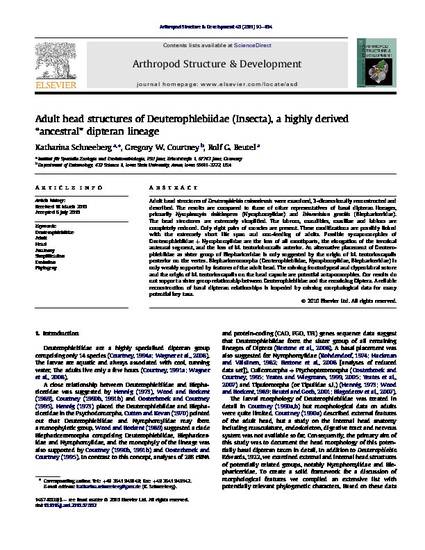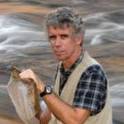
Article
Adult head structures of Deuterophlebiidae (Insecta), a highly derived “ancestral” dipteran lineage
Arthropod Structure and Development
(2011)
Abstract
Adult head structures of Deuterophlebia coloradensis were examined, 3-dimensionally reconstructed and described. The results are compared to those of other representatives of basal dipteran lineages, primarily Nymphomyia dolichopeza (Nymphomyiidae) and Edwardsina gracilis (Blephariceridae). The head structures are extremely simplied. The labrum, mandibles, maxillae and labium are completely reduced. Only eight pairs of muscles are present. These modications are possibly linked with the extremely short life span and non-feeding of adults. Possible synapomorphies of Deuterophlebiidae Nymphomyiidae are the loss of all mouthparts, the elongation of the terminal antennal segment, and the loss of M. tentoriobuccalis anterior. An alternative placement of Deutero- phlebiidae as sister group of Blephariceridae is only suggested by the origin of M. tentorioscapalis posterior on the vertex. Blephariceromorpha (Deuterophlebiidae, Nymphomyiidae, Blephariceridae) is only weakly supported by features of the adult head. The missing frontoclypeal and clypeolabral suture and the origin of M. tentorioscapalis on the head capsule are potential autapomorphies. Our results do not support a sister group relationship between Deuterophlebiidae and the remaining Diptera. A reliable reconstruction of basal dipteran relationships is impeded by missing morphological data for many potential key taxa.
Disciplines
Publication Date
2011
Citation Information
Katharina Schneeberg, Gregory W. Courtney and Rolf G Beutel. "Adult head structures of Deuterophlebiidae (Insecta), a highly derived “ancestral” dipteran lineage" Arthropod Structure and Development Vol. 40 (2011) p. 93 - 104 Available at: http://works.bepress.com/gregory_courtney/21/
